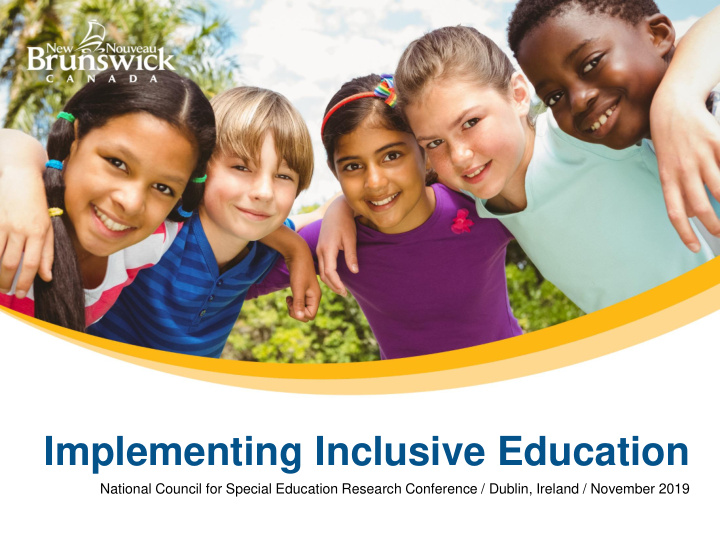



Implementing Inclusive Education National Council for Special Education Research Conference / Dublin, Ireland / November 2019
Inclusive Education in NB Public education is universal - the provincial curriculum is provided equitably to all students and this is done in an inclusive, common learning environment shared among age-appropriate, neighbourhood peers; Public education is individualized - the success of each student depends on the degree to which education is based on the student’s best interests and responds to his or her strengths and needs; and Public education is flexible and responsive to change.
Inclusive Education in NB Reflects current inclusionary practices (5.1) • Ensures learning for all • Removes barriers to learning • Promotes the common learning environment • Respects basic legal, civic and human rights for all • Focuses on individual’s strengths and needs
Including All Learners Most recently, the definition of inclusive education has expanded in an effort to engage students with disabilities (physical, intellectual, learning), as well as: • Indigenous/aboriginal students • Newcomer learners • Students from low socio-economic backgrounds • LGBTQ students and families • Gifted and talented students
Inclusive Education in NB Policy 322 The intentional removal of barriers… Environments that are intentionally designed to have …. Everyone at their Best
Inclusive Education in NB Our goal is personalized education where all students are learning in their zone of proximal development … both academically and social/emotionally .
Inclusive Education It takes a village • School is the extension of community • Families • Student voice • School leadership • Educators and paraeducators • Early childhood • Advocacy • Unions
Inclusive Education
Supporting Inclusive Education • This requires structural changes to organization, curriculum, teaching and strategies (Hehir, Grindal, Freeman, Lamoreau, Borquaye & Burke, 2016). • Hoppey & McLeskey (2014) characterized effective schools into two themes: school culture and organizational qualities ; and social instructional qualities . • School culture and organizational qualities include schools having a unifying vision, shared decision- making, and distributive leadership. • Social instructional qualities include high quality instruction and high quality, job embedded, professional learning
Best Practices to Supporting Inclusive Education • Universal Design for Learning (UDL) • Education Support Services Teams • Coaching Model • Response to Intervention (RTI) • Positive Behavioral Intervention & Supports (PBIS) • Integrated Service Delivery
Response to Intervention
Best Practices to Supporting Inclusive Education
Healthy and Inclusive High Schools New Brunswick ALL LEARNING IS RELATONAL • Deci and Ryan CAR model • Zone of proximal development and learning for adults • Relatedness as the underpinning for health and inclusive high schools in New Brunswick (Korotkov, 2019)
Healthy and Inclusive High Schools New Brunswick • “Of course, our focus is always the students, but a healthy school is when we all feel included, and we’re working towards the same purpose.” • “ Without relationships, you have the illusion of support, ” “…the priority is connecting with the student, curriculum comes second.” • “…it is not just FTE, all the teachers won’t help if the right teachers and structures are not in place • “Places grow from disagreement, it is healthy and respectful, we don’t run from it. You can have different viewpoints and people who challenge, it is how we get better.”
Bridging the Gap Between Research and Practice • School Review Indicators of Inclusion • Individual Education Plans - Quality Assurance – Annual Reviews • Student Needs Assessment- Shifting the Conversation
Bridging the Gap Between Research and Practice • Student Engagement • Teacher/Parent/Student Perception Surveys • Wellness Surveys • Integrated Service Delivery – Wrap-a-Round support data • Professional Learning • SEL • Complex Behaviour
Questions? Questions?
Recommend
More recommend